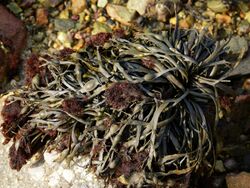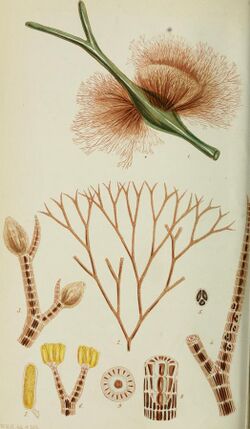Biology:Polysiphonia lanosa
| Polysiphonia lanosa | |
|---|---|

| |
| Brown algae Ascophyllum nodosum with hemi-parasitic red algae Vertebrata lanosa (Polysiphonia lanosa) | |
| Scientific classification | |
| (unranked): | Archaeplastida |
| Division: | Rhodophyta |
| Class: | Florideophyceae |
| Order: | Ceramiales |
| Family: | Rhodomelaceae |
| Genus: | Polysiphonia |
| Species: | P. lanosa
|
| Binomial name | |
| Polysiphonia lanosa (L.) Tandy
| |
Polysiphonia lanosa (Vertebrata lanosa;[1] Polysiphonia fastigiata) is a common species of the red algae (Rhodophyta) often to be found growing on Ascophyllum nodosum.[2]
Description
The thalli of this species form dense tufts,[2][3] each tuft up to 7.5 cm generally attached by rhizoids to the fronds of Ascophyllum. The erect cylindrical branches divide pseudodichotomously, that is forming two equal branches, one of the branches growing from a lateral branch.[2] A transverse section shows an axial cell surrounded by 12 to 24 peraxial cells. The axial cell is large and occupies about one third of the diameter of each branch, best seen in transverse section. It is deep brownish red in colour.[2]
Choreocolax polysiphoniae is a small parasitic alga which grows in a cushion-like manner to 1 mm in diameter on the branches of P. lanosa.[4]
Habitat
Widespread growing epiphytically on Ascophyllum nodosum wherever it is found and occasionally on other species of Fucus.[2][5]
Reproduction
The life history is a sequence of three phases: gametangial, carposporangial and tetrasporangial. Two of the phases are similar.[6] The plants are dioecious with spermatangial branches produced in tufts at the apices of the branches.[2] The cystocarps are borne, usually singly.[7] with a narrow ostiole from which carpospores are released. The tetraspores occur in spiral series[2] resulting from a simultaneous division into 4 equal spores.[8]
Distribution
Common around the British Isles and on the shores of Europe from Iceland, Norway to Spain . Also Greenland and Newfoundland to New England.[2]
References
- ↑ Bunker, F.StP.D., Maggs, C.A., Brodie, J.A. and Bunker, A.R. 2017 Seaweeds of Britain and Ireland. Second Edition. Wild Nature Press, Plymouth Press, UK. ISBN:9780995567337
- ↑ 2.0 2.1 2.2 2.3 2.4 2.5 2.6 2.7 Maggs, C.A. and Hommersand, M.H. 1993, Seaweeds of the British Isles Volume 1 Rhodophyta Part 3A Ceramiales. The Natural History Museum, London ISBN:0-11-310045-0
- ↑ Harvey, W.H. 1841. A Manual of the British Algae: London: John van Voorst
- ↑ Irvine, L.M.1983. Seaweeds of the British Isles. Volume 1 Rhodophyta Part 2A Cryptonemiales (sensu stricto), Palmariales, Rhodymeniales. British Museum (Natural History) ISBN:0-565-00871-4
- ↑ Lewis, J.R. 1964.p.12 The Ecology of Rocky Shores. The English Universities Press Ltd
- ↑ Dixon, P.S. 1973. Biology of the Rhodophyta. p. 187. Oliver and Boyd ISBN:0-05-002485-X
- ↑ Dickinson, C.I. 1963. British Seaweeds. The Kew Series
- ↑ Irvine, L. M. 1983. p.101 Seaweeds of the British Isles Volume 1 Rhodophyta Part 2A Cryptonemiales (sensu stricto) Palmeriales, Rhodymeniales. (British Museum) ISBN:0-565-00871-4
Wikidata ☰ Q3556236 entry
 |




